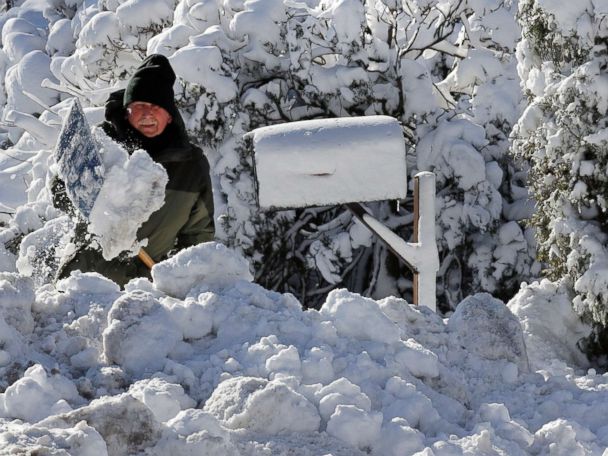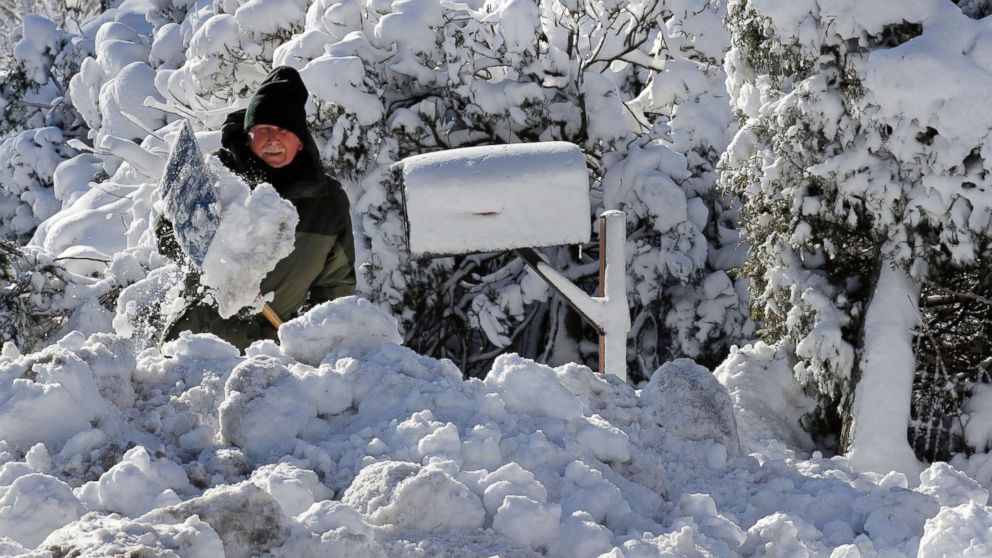





The snowstorm that battered the East Coast Wednesday and Thursday is gone, but now a major cold blast is moving in behind it. The frigid cold is spanning from the Midwest to the Southeast to the Northeast.
Wind chills this morning were below zero throughout the Northeast. Wind chills were even in the 30s in Miami.
The core of the coldest air will swing through the Northeast Saturday morning when wind chills approach minus 50 in New England.
On Saturday wind chills are forecast to be in the minus teens and minus 20s from Boston to Washington, D.C. Even Raleigh, North Carolina, will experience below freezing temps.
Those with prolonged exposure or those not dressed appropriately for the weather are in danger of frostbite and hypothermia, National Weather Service meteorologist Jay Engle told ABC News.
Frostbite results in the loss of feeling and color in affected areas — usually the nose, ears, cheeks, fingers, toes or chin, according to the U.S. Centers for Disease Control and Prevention (CDC). Frostbite could potentially cause permanent damage and, in severe cases, can lead to amputation, the CDC said.
Someone suffering from frostbite can be unaware of it because tissues that become frozen are numb, the CDC said. These are all signs of frostbite: numbness, white or grayish-yellow skin, or skin that feels unusually firm or waxy.
Dr. Randall Wexler, professor of family medicine at Ohio State University, warned: “Don’t rub your hands — if you have frost-nip or frostbite, rubbing actually causes tissue damage.”
If you think you are developing frostbite, “Keep the area covered if you can … because if you have frostbite on your hand and you pull off your glove, you may cause tissue damage,” Wexler said.
“That’s also when you want to start trying to raise your core body temperature — get rid of wet clothes, put on clothes that are warm and dry,” Wexler said.
There’s also hypothermia — or abnormally low body temperature — which can impact the brain, “making the victim unable to think clearly or move well,” the CDC said. “This makes hypothermia especially dangerous, because a person may not know that it’s happening and won’t be able to do anything about it.”
Warning signs for adults are shivering, exhaustion, confusion, fumbling hands, memory loss, slurred speech and drowsiness. Warning signs for infants are bright red or cold skin and very low energy, the CDC said.
Engle recommends to “dress in three or more layers. One big thick winter coat tends not to do the trick. You have to have a thick sweater underneath and then a lighter jacket on top of that and then your winter coat.”
“People really should keep their heads covered because that’s where majority of heat gets lost,” Engle added.
Wexler said you want to stay moving because that generates heat.
But Wexler added that you should avoid sweating. “If you are overheated and start to sweat, that lowers your body temperature, and makes you more susceptible to cold injury,” he said. “You want to be able to adjust your layers, zip and unzip.
In crowded places, Wexler added, “there’s also the so-called penguin effect.”
“”People in the center will have more warmth than people in the periphery. That’s obviously something people can’t control,” Wexler said. “You want to be able to adjust by wearing layers. You can also wear wicking clothing that can help if you do perspire.”
Wexler also recommended staying hydrated because “dehydration can help promote cold injury.”
Wexler also gave advice on who should be especially careful in the cold.
“The young and the elderly, because their ability to maintain core body temperature is harder than mid-age and younger adults,” he said. “Kids, especially babies, lose a disproportionate amount of heat from their head — that’s why you want to have a hat on their head when you’re out there. Older people are more at risk simply because changes that occur as we get older from fat and muscle mass, but also because it is more difficult to regulate our core body temperature as we get older.”
It’s also more difficult to maintain your core temperature if you are diabetic or taking decongestant antihistamines or certain blood pressure medications, Wexler said.
When the temperature dips, getting behind the wheel can prove to be a challenge. Problems include dead car batteries, iced-over windshields, broken car locks and driving with no traction.
Audra Fordin, founder of Woman Auto Know and the owner of Great Bear Auto Repair in Queens, N.Y., provided these tips:
1. Before you hit the road, check under the hood.
“If it’s really cold outside, you want to make sure that your battery is going to be good in the freezing cold weather,” Fordin said. “If you see any snow or blue stuff that’s growing off your battery, that’s an indication you want to go to the shop to have your battery checked.”
2. Iced out windshields? Turn to your wallet for help.
“If you get to your car and can’t see, pull out a credit card, and you can just wipe that frost away,” Fordin said.
3. Fighting a stubborn car lock? Get sanitizing.
“If your lock is frozen, Fordin said, “put the sanitizer on the key, and then put the key into the lock.”
4. If your car can’t gain traction, let your floor mat give an assist.
“Grab your floor mat, you’re going to put it underneath the wheel,” Fordin said. “That will give you enough traction to pull your car out and hit the road.”

